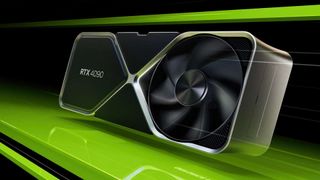Nvidia RTX 4090 'the new heavyweight champ' launches October 12 for $1599
The monstrous GeForce GPU will hit the shelves ahead of the RTX 4080 cards for an equally monstrous price.

Nvidia has just revealed the new RTX 4090 at today's GeForce Beyond Special Broadcast, one of the worst-kept secrets in tech. I mean, you could almost say that about any new bit of tech coming out of either the Nvidia, AMD, or Intel silicon skunkworks, but due to the voracious nature of PC gamers, the new Lovelace generation of RTX 40-series GPUs has been more leaky than an especially perforated teabag.
"Ada is a quantum leap for gamers," says Jen-Hsun. He's promising twice the performance of the RTX 3090 Ti in Flight Sim, and up to four times the performance in specific ray traced environments thanks to its new Lovelace architecture.
The new GeForce RTX 4090 is, as expected, a frankly monstrous GPU, and it's $1,599 and coming October 12. With a specs list that would make a data center blush, too, though there's still nothing concrete about those aside from the confirmation of 24GB of GDDR6X memory.
Jen-Hsun Huang held the card aloft during his GeForce focused intro to the GTC keynote, a conference traditionally dedicated to AI and more professional exploits than engaging in a little light frag fest of an evening.
And his arm looked like it was going to snap at the sheer weight of the damned thing.
With 16,384 CUDA cores and 24GB of GDDR6X memory, expected to be running at a heady 21Gbps, this is a beast of a graphics card. Though still one that comes in around the same 450W power demands as the RTX 3090 Ti, the previous top Nvidia GPU, but with twice the performance.

As you might expect, the price tag is accordingly massive. At $1,599 this is the stuff of ultra-enthusiast dreams, and normal human gamers' nightmares. Though it is at least lower than the RTX 3090 Ti started out life priced at.
Comic deals, prizes and latest news
Sign up to get the best content of the week, and great gaming deals, as picked by the editors.
So, when can you bankrupt yourself chasing ludicrous gaming frame rates? Huang announced that it would be on the shelves on October 12. Whether there'll be much stock of the RTX 4090 around launch… well, that's going to be tough to say until launch. Suffice to say that release day stock generally vanishes in a matter of minutes, and the chances are that such a massive slice of graphics silicon as the AD102 GPU inside the RTX 4090 will not be easy to manufacture.
As such, I doubt there's a massive number of complete GPUs coming out of TSMC's 4N foundries, and Nvidia's not going to flood the market with hugely expensive new cards, when it has a whole load of hugely expensive old cards still, y'know, flooding the market.






| Header Cell - Column 0 | RTX 4090 | RTX 4080 | RTX 4080 (!?) |
|---|---|---|---|
| GPU (rumoured) | AD102 | AD103 | AD104 |
| CUDA Cores | 16384 | 9728 | 7680 |
| Base Clock | 2235 | 2210 | 2310 |
| Boost Clock | 2520 | 2510 | 2610 |
| Memory Bus | 384-bit | 256-bit | 192-bit |
| Memory Type | 24GB GDDR6X | 16GB GDDR6X | 12GB GDDR6X |
| Memory Speed | 21Gbps | 22.5Gbps | 21Gbps |
| TDP | 450W+ | 320W+ | 285W+ |

Best gaming PC: The top pre-built machines from the pros
Best gaming laptop: Perfect notebooks for mobile gaming
It wasn't just the RTX 4090 that got its first reveal, however, as the RTX 4080 has also appeared at the Special Broadcast. Or should I RTX 4080s? In a bold move, Nvidia has announced an RTX 4080 with 16GB and a lower-specced RTX 4070 with 12GB. Except it's also called an RTX 4080.
Weird, huh?
These second- and third-tier cards will launch after the RTX 4090, and will likely be there to go head-to-head with AMD's Navi 31 GPUs when they arrive sometime in November. They're also not cheap, either, priced at $1,199 and $899 respectively.
It's going to be a fun, GPU-filled end of the year, people. And an expensive one.

Dave has been gaming since the days of Zaxxon and Lady Bug on the Colecovision, and code books for the Commodore Vic 20 (Death Race 2000!). He built his first gaming PC at the tender age of 16, and finally finished bug-fixing the Cyrix-based system around a year later. When he dropped it out of the window. He first started writing for Official PlayStation Magazine and Xbox World many decades ago, then moved onto PC Format full-time, then PC Gamer, TechRadar, and T3 among others. Now he's back, writing about the nightmarish graphics card market, CPUs with more cores than sense, gaming laptops hotter than the sun, and SSDs more capacious than a Cybertruck.
Most Popular






